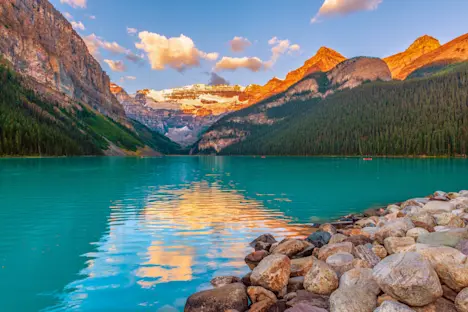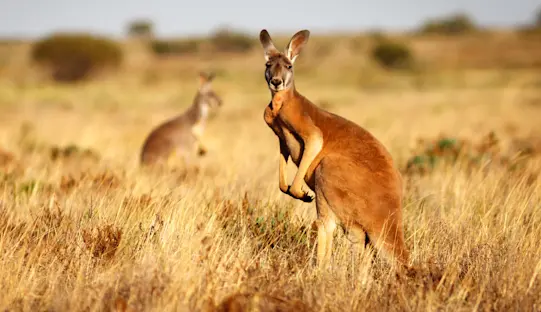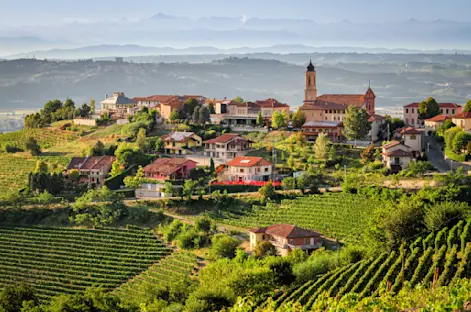It was just off the coast of Grímsey, a tiny Icelandic island about 25 miles north of the country’s mainland, that I spotted my first puffin. Easy to identify by its large head and orange beak, the adorable avian stood, partially hidden, among the island’s tufted greenery and rocky soil. I was beaming. Though I’d been to Iceland once before in the fall, these lovable birds who take up residence on the country’s cliffsides during summer months had already flown out to sea, where they live for most of the year. But here in mid-August, a few puffin stragglers remained. This was especially true on Grímsey, Iceland’s northernmost point and the only part of the country that crosses the Arctic Circle.
One of Europe’s most sparsely populated countries, Iceland is high on natural wonders, from thundering waterfalls and extraordinary black sand beaches to active volcanoes and bright-billed puffins. Traveling with Natural Habitat Adventures, you’ve got a good chance at seeing them all. Here are four ways to get up close to the country’s remarkable wildlife and otherworldly nature wonders.

Atlantic puffins © Nat Hab Expedition Leader Sabina Moll
Iceland: Circling the Land of Fire & Ice
Nat Hab’s Iceland: Circling the Land of Fire & Ice is an 11-day loop around this Nordic nation that combines multiple modes of transport, including private mini bus, chartered planes, 4×4 vehicles and boats. Whether it’s seeking out eider ducks, puffins and guillemots along rugged Aedey Island or navigating through fjords in search of humpback and minke whales, there’s plenty of local wildlife to take in along the way. Tour highlights range from an award-winning lava show in Vik to a thrilling big-tire SUV tour to Askja caldera, known for its dramatic eruptions and a visit to the fascinating lava formations around Lake Myvatn on horseback.

Nat Hab Guests glacier trekking © Andrew Ackerman
Ultimate Iceland Photo Expedition
Nat Hab’s 13-day Ultimate Iceland Photo Expedition takes advantage of the country’s spectacular summer light and wide range of stunning natural features, such as enormous waterfalls, active volcanoes, and black sand beaches, for a trip worthy of both amateur and highly skilled photographers alike. Spend a half-day photographing one of the world’s largest Atlantic puffin colonies in Borgarfjordur Eystri, and have your camera at the ready for Lake Myvatn, a shallow waterbody that’s seen more than 115 migrating bird species, including whooper swans, great northern divers and red-throated loons.

Diamond Beach © Nat Hab Expedition Leader Eddy Savage
Iceland & Greenland: A Nordic Discovery
Nat Hab’s Iceland & Greenland adventure is a unique 14-day itinerary combining less-traveled highlights of Iceland with an Arctic wilderness immersion in untouristed East Greenland. Walk on Iceland’s volcanic black sand beaches and see powerful waterfalls fed by the ice cap that spawns the country’s glaciers. Get deep into Iceland’s Central Highlands by 4×4, exploring basalt canyons and rhyolite mountains in rainbow hues, and hike in the dramatic environs of Skaftafell in Vatnajokull National Park. Scout for whales on boat cruises in Iceland’s Reykjavik Harbor and Greenland’s Sermilik Fjord. Then travel by plane, helicopter and private boat to Nat Hab’s Base Camp Greenland, which offers remarkable comfort in one of the most remote spots on Earth.
Circling Iceland by Ship
My own Iceland encircling began with a day exploring Reykjavik, the country’s bustling capital, on my own, taking in sights like the city’s distinctly curved Hallgrímskirkja church and dining on hot dogs topped with sweet mustard and remoulade before boarding the 148-guest National Geographic Explorer for our 10-day expedition. The ship—which got its start as a ferry vessel serving Norway’s coastal fords, and since repurposed for polar passages and temperate waters with a fully stabilized, ice-strengthened hull—was well-equipped with amenities like a gym and a sauna, and cozy nooks for reading and hot chocolate while out to sea.

Reykjavik
Still, it was in the “expedition” itself that this trip really sprung to life. Each of our seven or so stops en route around Iceland included a selection of active off-ship adventures—ranging in activity levels from easy to difficult—for passengers to choose from. For example, in the country’s far-flung Westfjords, we had the option of taking a scenic Zodiac ride along the coast or setting out on a lengthy hike, both ending at the base of Dynjandi, a stunning waterfall that cascades down the mountain like a bridal veil. Once there, we could climb up the mountainside for close-up views of this remarkable natural beauty or take it all in from below. The choice was ours.

Dynjandi
In Húsavík, a northern fishing town that played a starring role in the 2020 comedy film Eurovision Song Contest: The Story of Fire Saga, on-shore options ran the gamut from visits to impressive wonders like Iceland’s aptly dubbed “Waterfall of the Gods,” Goðafoss, and the volcanic Lake Mývatn to some in-town forest bathing and a soak in geothermal sea baths. I selected the latter, along with an impromptu visit to Húsavík’s delightful Eurovision Museum—an easy stop on my walk back to the ship.

Lake Mývatn
Due to a combination of rough weather and heavy marine traffic, our adventure included a few unscheduled highlights. One evening, high winds prevented us from going ashore on the Westfjords’ private Vigur Island, a fragile wildlife sanctuary that’s home to thousands of birds, including puffins, eider ducks and black guillemots. So instead, Felicity Aston, who co-owns the island with her husband, joined us aboard the Explorer. Aston is an author and climate scientist who, in 2012, became the first woman in history to cross Antarctica solo. In the ship’s lounge, she regaled us with stories so inspiring I couldn’t hold back my tears.

Westman Islands
Wild seas also kept us from making a safe landing at the Westman Islands of Surtsey and Heimaey, two young islands formed by underwater volcanic eruptions off Iceland’s south coast. However, the crew’s quick thinking took us straight back to Reykjavík, where we hopped on buses to catch the latest eruption of Iceland’s Sundhnúkur crater. Snapping pics of the boiling red lava as it lit up the sky, I was in absolute awe. It was an unforgettable experience and one that we wouldn’t have had without the itinerary’s built-in flexibility.

Back onboard each evening, we’d together in the ship’s lounge for a recap of the day and presentations by the ship’s expedition team, which included topics such as Icelandic folklore and the life of avians like Arctic terns, which migrate from the Arctic to the Antarctic annually—the longest commute in the animal kingdom. Occasionally, someone would spot a humpback whale diving for food in the distance. “Wherever you see masses of birds feeding in one area,” said an expedition team member, “you’ll typically also find whales.”

Humpback whale breaches with Mt. Kirkjufell in the distance. Humpbacks are one of the most common species to spot when whale watching in Iceland due to their playfulness, curiosity and inclination to swim closer to shore. © Nat Hab Expedition Leader Lianne Thompson
Mornings and afternoons at sea often included a presentation by National Geographic’s onboard photographer (Lindblad Expeditions always have a Nat Geo photographer onboard, in this case, Paulo Verzone), though one day in particular included something even a little more extra: the trip’s polar plunge. As I leaped from the deck of the Expedition’s mud room into the 45-degree sea, I felt invigorated. Afterward, a group of us poured into the ship’s sauna for warmth and camaraderie, sharing tales of past travels and trip highlights. While I didn’t yet know it, mine would include riding an e-bike through one of the largest calderas in the country, just outside of Bakkagerdi in Iceland’s wild northeast corner. That, and making new friends over shared meals, lakeside hikes and midnight card games.
In fact, by the end of the 10-day expedition, I’d not only scored my first puffin sighting in the wild but had a whole new onboard “family” to call my own.




































